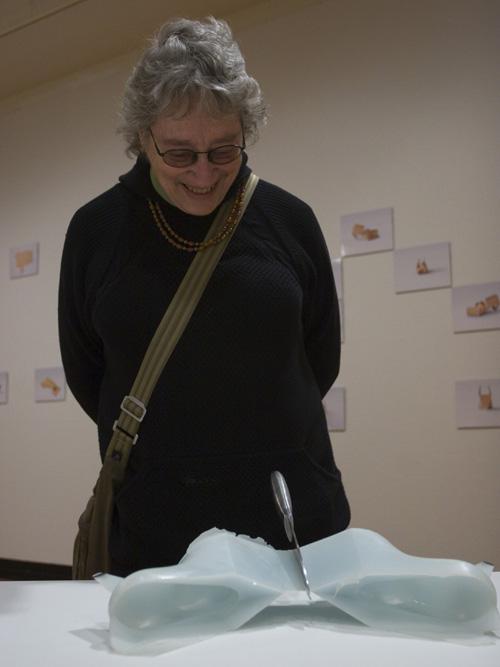Dare to walk a mile in these shoes
Feb 5, 2009
Last updated on May 13, 2016 at 07:36 p.m.
Laughing, Norma Marder turned and asked, “Am I the first person to react like this?”
This was asked in response to the Marloes ten Bh”mer shoe exhibit at the Krannert Art Museum. More specifically, Norma was laughing at an early step of creating sculpted shoes – a square wax block with a knife lodged into it.
“This is how many people feel about their shoes,” Marder said.
The exhibit, After Hours, presents the step-by-step procedure for making ultramodern shoes, from material developments and experiments to pouring, molding and de-molding processes, finally culminating in the finished pair of shoes. The final product of this creative process is the Beige-folded-shoe, said artist Bh”mer.
Get The Daily Illini in your inbox!
“It resembles a factory abandoned in the middle of production, and comments on the aesthetics, value and economics of the machine-made,” Bh”mer said in an e-mail.
Curators Judith Fox and Ginger Duggan came to Bh”mer with the idea of presenting her work as a process rather than a collection.
“I liked her work because it went beyond traditional icons of design and pushed the boundaries,” Duggan said.
Greg Callahan, senior in ACES and security at Krannert, said that it seemed to be a very unique exhibit.
“It tends to be older people coming in and the reaction is generally a lot of confusion,” Callahan said.
Norma Marder and her husband Herbert certainly caught a wave of that confusion while taking a look around the gallery. As the couple observed the pieces, they both had different interpretations of what they were seeing. Herbert saw it as an artist’s disappointment with the lack of craftsmanship of shoes in today’s culture.
“They are a basic craft that people wear on their feet,” he said.
Herbert also elaborated on his favorite part of the exhibit: the sketches on the wall. He described the sketches as looking like an organized set of variations. He did, however, feel like he should have more of a reaction to the sculpture of the shoes.
“But I don’t know anything of why I think or why I act the way I do,” Herbert said.
Norma saw the exhibit as a “fusion of glamour and discomfort”.
Norma, who used to work as a singer of avant-garde music, said the exhibit caught her attention because of the experimental aspect of it.
“I’m interested in experimental things of all sorts but I would be very surprised if people could actually walk in these,” she said.
She believes that Bh”mer was critiquing the idea that women’s footwear designers tend to focus more on style than comfort. Bh”mer, she said, shows this in a sculptural way.
Bh”mer has her own ideas for what her work means to her as the designer. She does not consider herself an artist even though her work is shown in art museums. Instead, she calls herself a product designer, focusing on challenging generic molds of women’s shoes through experiments with non-traditional technologies and materials.
“By reinventing the process by which footwear is made, the resulting shoes serve as unique examples of new aesthetic and structural possibilities, while also serving to criticize the conventional status of women’s shoes as cultural objects,” Bh”mer said.
As for the practicability of her work as actual footwear, Bh”mer said that making shoes in a non-conventional way and still making them technically accurate is a real challenge. She does, however, claim that people can and do wear these shoes just about anywhere.
Marder said that though she doubted the comfort of the footwear, she would give them a chance.
“If I could walk in them, I would definitely wear them,” she said.
Marloes ten Bh”mer’s After Hours exhibition will be featured at Krannert Art Museum until May 31.






